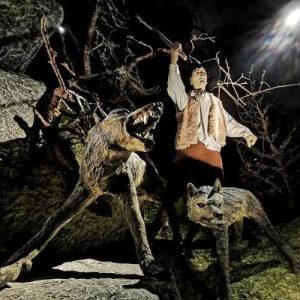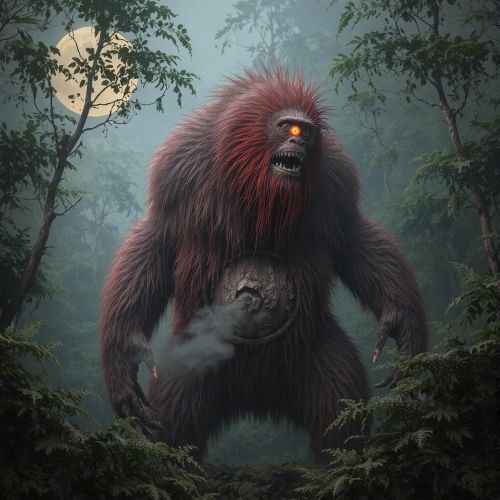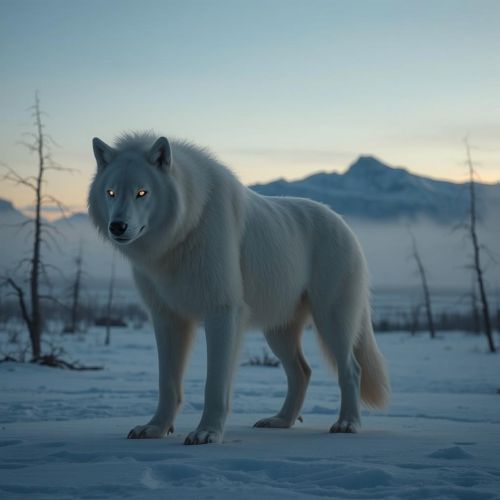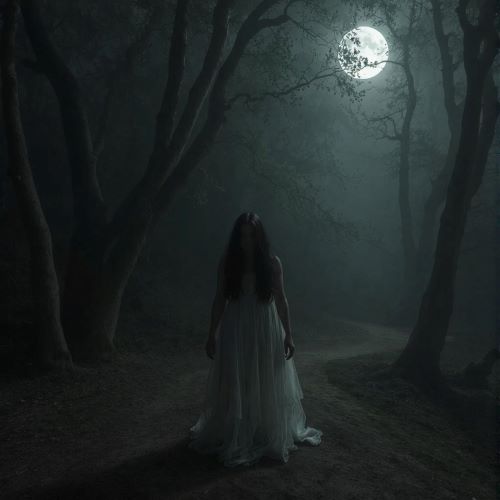Beast of Gévaudan : The Terror of France
| Description | |
|---|---|
| Origin | France |
| Classification | Cryptid |
| Demeanour | Evil |
| Habitat | Urban |
| Status | Not Proved |

Introduction
Between 1764 and 1767, the remote and mountainous province of Gévaudan in south-central France became the epicenter of terror. Villagers lived in constant fear of a monstrous predator that hunted humans with unprecedented ferocity. This creature, remembered as the Beast of Gévaudan (La Bête du Gévaudan), was blamed for the deaths of dozens—possibly over a hundred—of men, women, and children. Despite royal hunts, organized militias, and national attention under King Louis XV, the true nature of the Beast was never conclusively determined. Its reign of terror left an indelible mark on French history, inspiring centuries of speculation, folklore, and fascination that continues to this day.
Physical Attributes
Eyewitnesses consistently described the Beast of Gévaudan as unlike any ordinary wolf. It was reported to be as large as a calf or even a young bull, with a powerful, muscular frame covered in reddish-brown fur streaked with black. A dark stripe ran down its back, and it had a long, thick tail ending in a tuft. Its head was elongated, resembling that of a dog or boar, with a wide mouth full of sharp teeth and pointed ears that stood erect. Witnesses often mentioned that its chest was broad, and its gait was unusual—some claimed it moved with a bounding leap or even walked upright at times.
The creature’s resilience added to its fearsome reputation. Hunters claimed to have shot it multiple times without success, fueling rumors that the Beast was bulletproof or possessed supernatural protection. Reports also mentioned enormous tracks, unlike those of wolves, leading to theories that it could have been an exotic predator such as a lion, hyena, or a hybrid animal imported from abroad.
First Sighting/Reporting
The first recorded encounter with the Beast of Gévaudan occurred in the early summer of 1764. A young woman tending cattle in the Mercoire Forest near Langogne described a terrifying animal “like a wolf, yet not a wolf.” Her herd managed to protect her by charging at the creature until it fled. Soon after, on June 30, 1764, 14-year-old Jeanne Boulet was killed near Les Hubacs—widely recognized as the Beast’s first official victim. Her death certificate explicitly referred to “the ferocious beast,” signifying how quickly the phenomenon gripped local consciousness.
Over the following months, reports of attacks spread rapidly. Victims were found with their throats torn out or partially eaten, often in daylight and near their homes. By autumn of 1764, the French press began covering the story, and La Gazette de France described the Beast as a “cruel animal that devours everyone it meets.” The terror soon spread beyond Gévaudan, captivating all of France and even reaching the royal court in Versailles.
Other Names
The creature became known across France as La Bête du Gévaudan, while in the local Occitan dialect it was called La Bèstia de Gavaudan. As the legend grew, storytellers and newspapers gave it other titles such as “The Monster of the Margeride,” “The Gévaudan Beast,” and simply “The Beast.” Later retellings associated it with werewolf legends, calling it “The Last Chimera” or even suggesting it was a cursed man-beast. These varying names reflect both regional linguistic diversity and the evolving mythology surrounding one of Europe’s most infamous predators.
Modus Operandi
The Beast of Gévaudan’s pattern of attack was as brutal as it was baffling. It primarily targeted humans—especially women and children working in fields or forests—rather than livestock. Victims were often ambushed from behind, with injuries concentrated on the head and neck. Many were decapitated or found with their throats torn out, and contemporary accounts mention that some bodies were partially consumed.
The animal showed no consistent fear of humans or domestic animals and was known to attack even in broad daylight. Witnesses spoke of its cunning—it seemed to watch and stalk its prey before striking with terrifying speed. Reports of multiple attacks occurring miles apart on the same day led some to believe that more than one Beast existed or that a pack of animals was responsible. Others, steeped in religious fear, claimed it was a demonic punishment or a werewolf sent to torment humanity.
Despite numerous hunts organized by the local nobility and royal envoys, the Beast evaded capture time and again. Its uncanny intelligence, endurance, and ability to vanish reinforced the belief that it was no ordinary predator.
Pop Culture References
The legend of the Beast of Gévaudan has endured far beyond 18th-century France, inspiring countless adaptations across literature, film, and television. The 2001 French film Brotherhood of the Wolf reimagined the story as a stylized historical thriller, portraying the Beast as a trained lion clad in armor. The 2022 horror film The Cursed offered a supernatural interpretation, linking the creature to a gypsy curse.
In music, the German power metal band Powerwolf released the song “Bête du Gévaudan” in 2021, blending historical reference with gothic myth. On television, the MTV series Teen Wolf introduced La Bête du Gévaudan as an ancient werewolf antagonist, while podcasts and documentaries continue to explore its mystery. The Beast also features in novels such as Patricia Briggs’ Hunting Ground and video games like Assassin’s Creed Unity and The Witcher, solidifying its presence as a global pop culture icon symbolizing the intersection of folklore and horror.
Current Status
After years of terror, the attacks in Gévaudan abruptly stopped in 1767. On June 19 of that year, local hunter Jean Chastel reportedly shot and killed a massive wolf during a royal-sanctioned hunt led by the Marquis d’Apcher. The animal’s carcass was examined by surgeon Dr. Boulanger, who noted its unusual size and features. It was then sent to Versailles, though decomposition prevented the king from ever seeing it. Following Chastel’s kill, no further attacks occurred, and the region slowly returned to normalcy.
Historians and scientists have debated the Beast’s identity ever since. The most accepted explanation is that a series of large wolves or wolf-dog hybrids were responsible for the killings. Others suggest an escaped exotic predator, such as a hyena or lion, brought to France by travelers or circuses. A few fringe theories even claim human involvement—perhaps a trained animal used by a deranged killer.
While the true identity of the Beast of Gévaudan remains unsolved, the legend has transcended its historical origins to become a powerful cultural symbol. It represents the human struggle to explain the unexplainable, the tension between nature and civilization, and the deep psychological imprint of fear on collective memory. Today, the villages of the former Gévaudan province celebrate their infamous past with museums, guided tours, and festivals, ensuring that the mystery of the Beast lives on as one of Europe’s most haunting and enduring legends.
Source
Wikipedia contributors. (2004, November 26). Beast of Gévaudan. Wikipedia. https://en.wikipedia.org/wiki/Beast_of_G%C3%A9vaudan
Green, J. (2024, August 8). The ‘Beast of Gévaudan’ Killed Hundreds in 18th Century France. Vice. https://www.vice.com/en/article/beast-of-gevaudan-werewolf-theories/
Public Domain Review. (2019, June 18). The Beast of Gévaudan (1764–1767). https://publicdomainreview.org/collection/the-beast-of-gevaudan-1764-1767/
Museum Hack. (2022, November 19). The Real Story of the Beast of Gévaudan. https://museumhack.com/beast-gevaudan/
Gévaudan Authentique. (2025, January 21). The legend of the Beast of Gévaudan. https://www.gevaudan-authentique.com/?page_id=44245&lang=en
France Today. (2019, July 16). The Legend of the Beast of Gévaudan. https://francetoday.com/learn/history/the-legend-of-the-beast-of-gevaudan/
Echase, D. (2024, November 3). The Beast of Gevaudan. https://dannyechase.com/blog/beastofgevaudan/
Mende Coeur Lozere. (2025, October 12). The Beast of Gevaudan. https://www.mende-coeur-lozere.fr/en/explore-lozere/gevaudan/beast-gevaudan/
HISTORY. “What Was the Beast of Gévaudan?” May 28, 2020.https://www.history.com/articles/beast-gevaudan-france-theories









